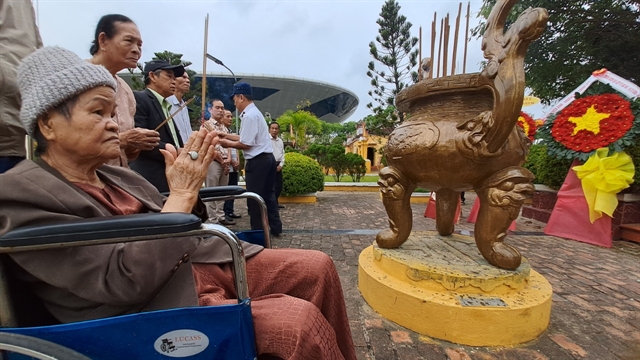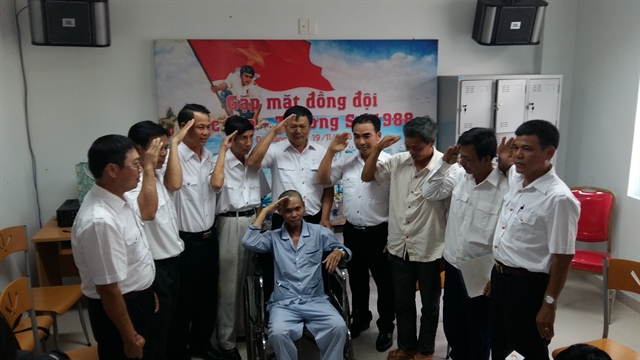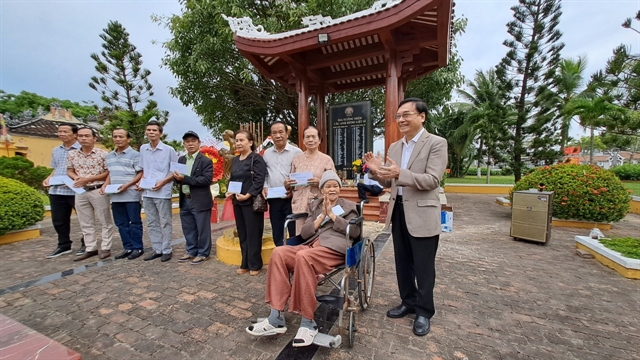 Society
Society

 |
| Lê Thị Lan, 82, joins a memorial service for 64 martyrs killed in the Gạc Ma (Johnson South) Reef fight against Chinese invaders in 1988. Memorial services are held annually at provinces and cities nationwide in honour of the soldiers who died protecting the islands and sea of Việt Nam. VNS Photo Công Thành |
ĐÀ NẴNG – In the past 36 years, Lê Thị Lan, 82, has had only two dreams of her son, Nguyễn Hữu Lộc, a navy martyr, since he was killed in the fight against Chinese invaders, while protecting the Gạc Ma (Johnson South) Reef, part of the Trường Sa (Spratly) Archipelago, in 1988.
Lộc, a navy engineer, and his 63 teammates were killed in the unequal battle against six Chinese frigates on March 14, 1988. His remains were lost in the depths of the sea, but his soul still wandered in the mother’s nightmares.
 |
| A veteran lights candles in a memorial ceremony for the 64 navy soldiers killed in waters off Gạc Ma Reef of Trường Sa (Spratly) Archipelago of Việt Nam in 1988. VNS Photo Công Thành |
He left home after repairing his mother's degraded house and a week-off for Tết (lunar New Year) holidays, and that was the last time his mother saw him.
“He left home for construction of islands and reefs off Trường Sa. He died at the age of 21, just over a year after recruitment in Regiment No 83 – an engineering navy unit,” Lan said at a memorial ceremony at Nại Nam Communal House by the Liaison Committee for soldiers of Trường Sa (Spratly) Islands (1984-1988).
“I dreamt of his legs and a personal suit case floating in the sea, while in another dream he was screaming for food and water. His body would be sunken with the ship deep in the sea for decades,” she speculated.
Lan said her family was called for DNA identifications of the missing martyrs at sea, but had not yet seen a notice or report on the result.
The mother had to use wheelchair after a year of treatment for a stroke, and she is now living with support from the youngest of her 10 children.
“I still pray for his soul resting in peace in the arm of Mother Earth and the country’s everlastingness. I imagine that my son was travelling on a long trip to the seas and islands. He will never die.”
Lan was taken to Trường Sa twice, where she released wreaths and candles to his son’s soul near Gạc Ma Reef.
Nguyễn Văn Bình, 56, a close friend of Lộc, also joined the sea trip to Trường Sa Islands 36 years ago, but he was assigned for construction at Đá Nam (South Reef).
“We were teammates at high-school and soccer team. We all joined in the navy as engineers in 1988. It was the toughest and most dangerous time for us, when all Vietnamese navy ships were illegally rammed and hit by Chinese Navy ships on trips to Trường Sa Islands,” Bình recalled.
 |
| Portraits of 64 martyrs killed in the Gạc Ma Reef combat protecting the islands and sea of Việt Nam against invasion of Chinese navy force in 1988. Photo courtesy of Nguyễn Văn Tấn |
Bình said the trip took him and a group of 30 naval engineers two weeks, confronting aggressive provocation and threatening force from Chinese ships.
He said the team had weeks to unload construction material from ship to the reef for building towers marking the country’s sovereignty over the Trường Sa.
Born in Đà Nẵng, Bình served in the island construction team under Regiment No 83, then was sent to build concrete structures on Cô Lin (Collins Reef, or Johnson Reef North) and Len Đao (Landsdowne) Reef after Gạc Ma Reef was illegally occupied by Chinese invaders six month later.
“Around late September of 1988, two ships were sent to Collins Reef and Landsdowne Reef with construction material. We had to work at night to complete the temporary bases on the two reefs,” he said.
The construction teams then stayed on Sinh Tồn (Sin Cowe) Island in Trường Sa of Việt Nam for a month before going home, he recalled.
Bình left the navy at the rank of sergeant major in 1990, and then made his living as a mason and electrician.
“Nine martyrs in Đà Nẵng were all my classmates and close friends. We gather annually to commemorate the naval soldiers who died in the fight to protect Gạc Ma Reef. They are still living with us every day. It seems that they were sailing at sea and living on islands and reefs.”
Lê Thị Giới, younger sister of Lê Thế - one of the 64 martyrs – said the family still hopes for the missing corpse, even though it’s in vain.
“My mother, Trần Thị Huệ is ageing, but she still believes in magic support in seeking a piece of her only son. My brother was killed at age 22, he was still single,” Giới shared.
 |
| Ex-naval soldiers of Trường Sa gather in a memorial ceremony in Đà Nẵng. They were survivors of the fight against Chinese invaders in Gạc Ma Reef in 1988. VNS Photo Công Thành |
A memorial service was held in honour of 64 martyrs who fought to protect the Gạc Ma (Johnson South) Reef in 1988, at Mân Quang Wharf by the liaison of Navy Engineering Regiment No 83.
Sixty-four engineers were killed, 11 wounded and nine imprisoned by the Chinese navy. Two unarmed cargo ships of Việt Nam were sunk in the incident.
March 14 is an annual event honouring martyrs and their families as well as veterans who helped create a historical landmark for the Vietnamese navy in the protection of the country’s islands and sea.
Many martyrs were laid to rest at sea. Nine martyrs were from Đà Nẵng and 14 from Quảng Bình Province.
Research on Gạc Ma Reef
Researcher Võ Hà released the book Trường Sa 1988 – Hồ Sơ Một Sự Kiện Lịch Sử (Trường Sa 1988 – A Dossier on a Historical Incident) on the protection and development of Trường Sa (Spratly) Archipelago of Việt Nam, focusing on the protection of Gạc Ma (Johnson), Colin and Len Đao reefs in Việt Nam’s Trường Sa Islands against Chinese invasion in 1988.
In his foreword to the book, Hà wrote: "China illegally occupied some parts of Trường Sa Islands between 1976-1988, and the fight of the Gạc Ma (Johnson) reef was an outbreak of the 22-year-invasion by China of Việt Nam’s islands and seas.”
 |
| Lương Minh Sâm (first right) presents gifts to families of naval martyrs of the Gạc Ma Reef incident in 1988. Lecturers and students from Đà Nẵng City's Đông Á University have donated gifts and support to martyrs' families 11 years in a row. VNS Photo Công Thành |
"In 1974, China invaded west of the Paracels and illegally occupied the entire Hoàng Sa Island under management of the Republic of Việt Nam, or the Sài Gòn administration.”
The book also highlights the strong will and spirit of Vietnamese people in protecting the country’s sovereignty over the Trường Sa and Hoàng Sa, which Việt Nam has continuously exercised and managed from the 17th to 19th century and until today, he added.
An article by Ngọc Đản, published on Nhân Dân newspaper on March 24, 1988, reported that Chinese warships (No 556, 653, 552, 505, 502) attacked Vietnamese ships in waters off Gạc Ma and Colin reefs.
"Chinese ship 505 rammed the anchored HQ 604 ship of Việt Nam before sending a motorboat with an armed group of 71 sailors to attack the Vietnamese flagged Gạc Ma Reef.
"The Chinese forces, who failed in the fight against an unarmed defence of Vietnamese naval engineers, fired on Vietnamese flag holder Trần Văn Phương in an effort to seize the Vietnamese flag.
"Chinese war ship 502 began firing artillery at the Vietnamese HQ 604 ship and 40 Vietnamese engineers on the Gạc Ma Reef, while other Chinese war ships (552 and 556) also launched artillery fire on Vietnamese ship HQ-505 in Colin Reef and HQ-605 in Len Đao Reef at the same time.
"Two Vietnamese ships HQ-604 and HQ-605 were sunk, but the captain of HQ-505, Vũ Phi Trừ, quickly decided to land the ship on the rear of Colin Reef, marking the country’s sovereignty of the reef," the article wrote. VNS




